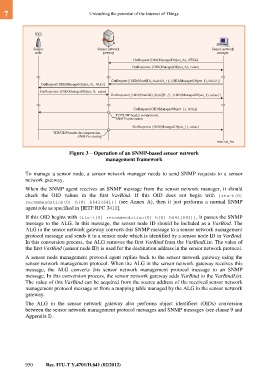Page 964 - Unleashing the potenti al of the Internet of Things
P. 964
7 Unleashing the potential of the Internet of Things
Sensor Sensor network Sensor network
node gateway manager
GetRequest{OID(ManagedObject_A), NULL }
GetResponse {OID(ManagedObject_A), value }
GetRequest{{OID(NodeID), NodeID_1 }, {OID(ManagedObject_1), NULL }}
GetRequest{OID(ManagedObject_1), NULL }
GetResponse {OID(ManagedObject_1), value }
GetResponse{{OID(NodeID), NodeID_1 }, {OID(ManagedObject_1), value }}
GetRequest{OID(ManagedObject_1), NULL }
TCP/UDP header compression,
SNMP optimization
GetResponse {OID(ManagedObject_1), value }
TCP/UDP header de-compression,
SNMP re-storing
H.641(12)_F03
Figure 3 – Operation of an SNMP-based sensor network
management framework
To manage a sensor node, a sensor network manager needs to send SNMP requests to a sensor
network gateway.
When the SNMP agent receives an SNMP message from the sensor network manager, it should
check the OID values in the first VarBind. If this OID does not begin with {itu-t(0)
recommendation(0) h(8) h641(641)} (see Annex A), then it just performs a normal SNMP
agent role as specified in [IETF RFC 3411].
If this OID begins with {itu-t(0) recommendation(0) h(8) h641(641)}, it passes the SNMP
message to the ALG. In this message, the sensor node ID should be included as a VarBind. The
ALG in the sensor network gateway converts this SNMP message to a sensor network management
protocol message and sends it to a sensor node which is identified by a sensor node ID in VarBind.
In this conversion process, the ALG removes the first VarBind from the VarBindList. The value of
the first VarBind (sensor node ID) is used for the destination address in the sensor network protocol.
A sensor node management protocol agent replies back to the sensor network gateway using the
sensor network management protocol. When the ALG in the sensor network gateway receives this
message, the ALG converts this sensor network management protocol message to an SNMP
message. In this conversion process, the sensor network gateway adds VarBind to the VarBindList.
The value of this VarBind can be acquired from the source address of the received sensor network
management protocol message or from a mapping table managed by the ALG in the sensor network
gateway.
The ALG in the sensor network gateway also performs object identifiers (OIDs) conversion
between the sensor network management protocol messages and SNMP messages (see clause 9 and
Appendix I).
950 Rec. ITU-T Y.4701/H.641 (02/2012)

